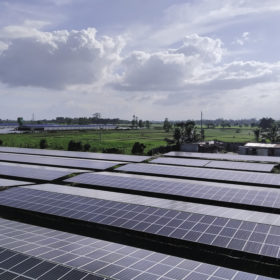Enabled by trade
The story of the modern PV industry is one defined by international collaboration and partnerships. Fundamental research, production tool development, manufacturing know-how, financial innovation and supportive policy measures have all taken place in certain parts of the globe, to be deployed, tweaked, improved upon and mastered in others. And the cumulative effect is the highly […]
Trade war shadows all but solar
Solar stocks outperformed the broader market in August. The Guggenheim Solar ETF (TAN) increased by 2.0% vs. the S&P 500 and Dow that decreased 0.9% and 1.1% respectively. Canadian Solar (CSIQ), Azure Power (AZRE), First Solar (FSLR), SolarEdge (SEDG) and Enphase (ENPH) all delivered a strong Q2 and strong guidance for Q3.
Safety is paramount
When Sony first commercially introduced lithium-ion batteries in 1991, the industry recognized their potential to revolutionize portable electronics. Ever since, there have been countless efforts to improve the technology, with many researchers focusing on energy density and longevity, in line with demand from emerging applications such as electric vehicles (EVs) and on-grid energy storage. Julian Jansen and Youmin Rong of IHS Markit discuss the effect of safety concerns on this rapidly growing global market.
Germany’s PV cap must go – now
Last month’s column pointed out the transregional causes and trends that could lead to a year-end rally, the associated module and inverter bottleneck, and an inevitable increase in prices. This month, Martin Schachinger of pvXchange homes in on the German market to show what consequences unwise action – or rather, inaction – by the federal government could have for the further, urgently needed expansion of photovoltaics.
PERC cells: From shortage to surplus
After the “June rush” to complete solar projects in China – as well as the commissioning rush in Vietnam, which saw higher-than-expected demand of 4 GW in the first half – the growth of the regional solar market started to slow down in July and August, before anticipated Chinese demand picks up the slack again. With unexpectedly low demand in the third quarter, module manufacturers reacted first by marginally reducing utilization rates. Cell producers then cut production after cell prices collapsed.
All that solar jazz
As 2019 enters its final quarter, the solar industry continues to face headwinds, even as the markets for solar deployment in Europe, the United States, and Australia remain strong. Paula Mints of SPV Market Research takes us through what to expect up until 2021.
All eyes on the Indian government
India’s total installed solar capacity touched 34.1 GW on June 30, 2019. The total was split between 27.9 GW of utility-scale PV, 4.6 GW of rooftop solar and 1.26 GW of off-grid solar. The nation’s total project pipeline – projects allocated to developers and those in various stages of development – stood at 19.69 GW as of June 30. Bridge to India’s Sai Nandamuri looks at the outlook for Indian solar in 2019 and 2020.
The specter of PV protectionism
Trade tariffs are spreading across the global PV industry. The United States has been especially active with its sandwich of old antidumping and countervailing duties coupled with new Section 201, 232 and 301 duties. Some of these are part of the Sino-U.S. trade dispute; others impact not only Chinese producers, but manufacturers around the world. So, what will be the impact of this new era of PV protectionism on the solar sector?
Under-the-radar US residential markets
All American residential solar markets were not created equal. While states such as California, New York and Massachusetts have legacy markets that have existed in strength for well over a decade, some have taken longer to find their footing. A look at three promising U.S. states for residential solar.
Diverse segments drive deployment in Bangladesh
In July, Bangladesh’s renewable generation capacity surpassed the 600 MW milestone. A solid achievement, even though the country still lags behind the government’s official plan to produce 10%, or 2 GW, of its electricity from clean sources by 2020. But with deployment rising in both the commercial rooftop and utility-scale solar segments, development could be poised to accelerate.










